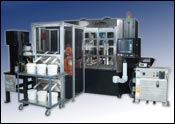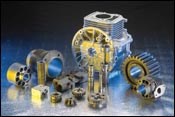Precision Hole Making At High Cpk
Many shops and plants are moving from manual honing machines to CNC honing machines, as well as to robotically automated cells capable of controlling holes size to accuracies of 0.25µm (0.00001 inch). The inherent accuracy and process stability of honing have promoted this changeover because precision parts produced today must meet high Cpk requirements.Honing can produce a specified finish and a desirable crosshatch pattern on the bore surface, which helps retain a lubricating film for sliding components. Makers of outdoor power equipment, motorcycles, ATVs, hydraulics, pneumatics, gears, and valves are some of the users who have "discovered" automated honing in their drive to make parts with tolerances as tight as ±0.0002 inch (±5 µm) at high Cpk levels.
Share





Honing is one of the few metalworking processes for which manual machines are still popular, and it is used in thousands of shops for basic bore sizing and finishing. This is in the process of changing because of recent developments in bore sizing technology, says Rich Moellenberg, custom products manager for Sunnen Products Company (St. Louis, Missouri). The force behind this change is the need for greater efficiency, tighter sealing, quieter operation and longer life for products in which a part rotates on a shaft, or a piston slides inside a bore.
According to Mr. Moellenberg, the industry is meeting this challenge by turning to CNC honing machines, as well as to robotically automated cells capable of controlling hole size to accuracies of 0.25µm (0.000010 inch). The inherent accuracy and process stability of honing have promoted this changeover because precision parts produced today must meet high Cpk requirements—“something that is not always as easy with boring, reaming and so on,” he says. He adds that honing can produce a specified finish and a desirable crosshatch pattern on the bore surface, which helps retain a lubricating film for sliding components. Mr. Moellenberg cites the makers of outdoor power equipment, motorcycles, ATVs, hydraulics, pneumatics, gears and valves as users who have “discovered” automated honing in their drive to make parts with tolerances as tight as ±0.0002 inch (±5 µm) at high Cpk levels.
Various hole-making processes, such as boring, drilling and reaming are capable of producing excellent tolerances, but when a high Cpk requirement is imposed, Mr. Moellenberg says that it changes the picture entirely. As he notes, when the target is 1.33 Cpk, manufacturers typically find they have to hold about 60 percent of the print tolerance; at 1.67 Cpk, it drops to about 40 percent of tolerance. Holes produced satisfactorily on a lathe for years that suddenly have to meet process capability of 1.33 or 1.67 Cpk may require a much narrower bell curve of distribution. “Flyers” at the fringes of the curve become unacceptable.
Why does a high Cpk constrict the tolerance band? As Mr. Moellenberg explains, Cpk is calculated as upper tolerance minus the mean or as the mean minus the lower tolerance, whichever is smaller, and this is divided by three times the standard deviation. A stable, consistent process helps keep the standard deviation in the denominator small. If the mean of the group can be focused exactly in the middle of the tolerance range, it helps produce the largest numerator.
“To get that large numerator and small denominator, you not only want a process where variability is small, but also you want a process in which you can accurately target your mean to a certain value and hold it there. A lathe may get to just a certain value, but then, if tweaked a little, it jumps to a value out of spec,” Mr. Moellenberg says. He says that hard turning, although an excellent technique, is more difficult to control, especially for microfinishes. “In contrast, a computer-controlled hone can get within 10 millionths of a specified size, and with the resolution on the feed systems of today’s machines, the variability is very small,” he states.
According to Mr. Moellenberg, the capability of today’s automated CNC honing systems, such as those based on Sunnen’s SV family of machines, meet today’s high bore-sizing/finishing requirements, producing hole size accuracies of 0.25 µm (0.00001 inch), with minimal variation and no operator intervention. The SV machines, for example, use an innovative tool-feed system and can be equipped with integrated post-process air gaging. The combination of servo air gaging and proprietary tool-feed control eliminates the need for an experienced honing operator to tweak the process, Mr. Moellenberg says. The air gaging system takes post-process measurements of parts while they are still fixtured on the machine’s rotary table and makes any necessary compensation in the honing process for bore diameter size or bore geometry.
In-process air gaging integrated in the honing tool has been around for a few decades, but is best used for automatic shut-off, Mr. Moellenberg says, adding that the post-process system produces the significantly greater accuracy needed for tool-size control when working to high Cpk standards. It eliminates measurement uncertainties caused by an undersized or worn gage probe, which can occur with a hone-head air gage. It also allows measurement without interference from the swarf and oil present during the process.
“This type of servo-controlled hone knows precisely where the tool is, how much it has been fed and so on. Some of the older honing machines fed the tool based on force—the machine sensed how hard it was pushing, but it didn’t really know tool size at any given time. These new machines do,” Mr. Moellenberg says. On these machines, a TurboHone multi-stone tool or a diamond-plated CGT Krossgrinding tool can be adjusted for size with a resolution of 0.25 µm (0.00001 inch).
The servo-controlled stroke system ensures a consistent crosshatch pattern and can dwell in any part of the hole, end-to-end, selectively removing stock. According to Mr. Moellenberg, this enables these machines to achieve ultra-precise straightness and roundness. The system can also make corrections that are not intuitive for an operator. Selectable control features, such as “correct for bore shape” allow the operator to select a “problem” bore image, such as barrel or taper, and the machine will automatically correct the part. Combined with feedback from air gaging of finished parts, this honing system makes high-Cpk hole making the fully automated process today’s manufacturers want, he says.
Read Next
Building Out a Foundation for Student Machinists
Autodesk and Haas have teamed up to produce an introductory course for students that covers the basics of CAD, CAM and CNC while providing them with a portfolio part.
Read MoreRegistration Now Open for the Precision Machining Technology Show (PMTS) 2025
The precision machining industry’s premier event returns to Cleveland, OH, April 1-3.
Read MoreSetting Up the Building Blocks for a Digital Factory
Woodward Inc. spent over a year developing an API to connect machines to its digital factory. Caron Engineering’s MiConnect has cut most of this process while also granting the shop greater access to machine information.
Read More



























.jpg;maxWidth=300;quality=90)




